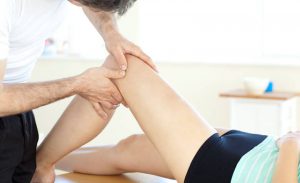We are delighted to announce the release of the “Essential MAT Assessments” program. I hope you enjoy our newest course addition to the Freedom From Pain Institute library of continuing education courses. My staff and I created this program in response to many requests for an assessments-only hands-on course to accompany the techniques found in my Myoskeletal books and videos. During these tests, we’ll be addressing active and passive ranges of motion, pain provocation, neurological deficits, and soft tissue injuries such as tendinopathies. Here’s a fly-by on topics we’ll be discussing during the assessment process.
Flexibility, Range of Motion (ROM) and Mobility
Flexibility refers to the ability of a muscle to lengthen, whereas ROM describes how well the joints in the body move. To have good ROM, a joint must be flexible. For example, the knee must have good extensibility to exhibit full ROM. The ability of a joint to move actively through a ROM without restriction or discomfort is termed mobility. It’s important to understand that quality of motion at a joint is usually far more important than quantity of motion. Since all our movements are governed by the central nervous system, the brain will limit extensibility, ROM, and mobility if it feels there is a potential danger. For example, too much extensibility is a potential danger to the body, so the brain acting as a governor will make sure it is only used in a manner that is known to be safe.
Pain Provocation Exams
Pain may be described as an unpleasant sensory and emotional experience associated with actual or potential tissue damage. Each of us learns the application of the word through experiences related to injury in early life. Many clients report pain in the absence of actual tissue damage, and when performing an initial intake evaluation, there is often no way to distinguish whether the client’s perceived pain is due to actual tissue damage. Therefore, if the client labels her experience as pain and reports it in a way consistent with pain caused by tissue damage, it should be accepted as pain. Basically, pain is the body’s message that something is awry. Up to 90% of America’s population will experience recurring low-back, neck and head pain in they lives. These cases do not necessarily represent injury at that particular site, but are usually symptoms of dysfunction in associated structures. So when performing pain provocation exams, we will evaluate the client in the context of all related structures.
Orthopedic Tests
Orthopedic tests are designed to evaluate individuals for musculoskeletal impairment and are generally more reliable when clustered with other physical exams. The general plan for physical assessment includes history taking, examining how the client moves, determining how individual joints move and evaluating the integrity of the nervous system. Most orthopedic tests are used to evaluate pain, loss of joint play, and muscle extensibility, but it’s important to remember these are not stand-alone assessments, and they are not meant to “diagnose” a condition. A medical history and all the evaluative tools mentioned above are necessary for a more complete representation of the client’s health and the nature of injury. In this “Essential MAT Assessments” course, we will be using orthopedic tests in conjunction with neurologic and anatomical landmark exams to help us develop a more holistic picture of our client’s health.
Save 25% off Erik’s newest course as part of our pre-launch sale!!
This course is in the final stages of development. Online access will be available in the next week and the home study version with manual and DVDs is expected to be ready for shipping on January 15th.
Buy it now as part of our pre-launch sale. Not only will you save 25% off the regular price when we release the course, but you’ll be able to write it off on this year’s taxes! This course is not available from our main sales site, but is available exclusively to our newsletter subscribers, blog subscribers, and Facebook Group members.
On sale this week only!
Save 25% off the "Dalton Technique Treasures" eCourse
The “Dalton Technique Treasures” eLearning course is a compilation of some of Erik’s favorite Myoskeletal Alignment Techniques (MAT). Learn MAT techniques to assess and address specific sports injuries, structural misalignment, nervous system overload, and overuse conditions. ON SALE UNTIL July 29th! Get Lifetime Access: As in all our eLearning courses, you get easy access to the course online and there is no expiry date.







